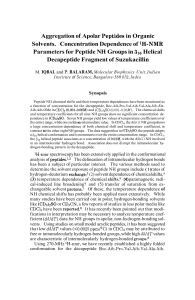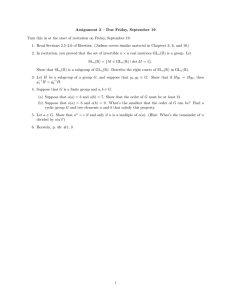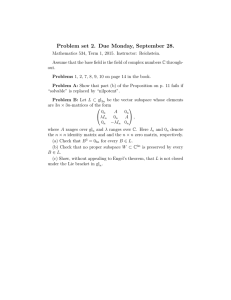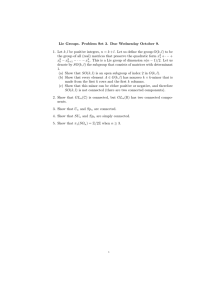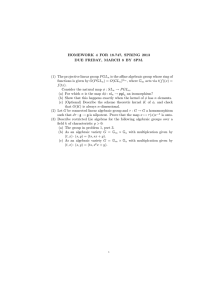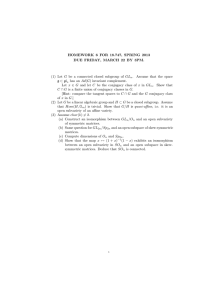of
advertisement
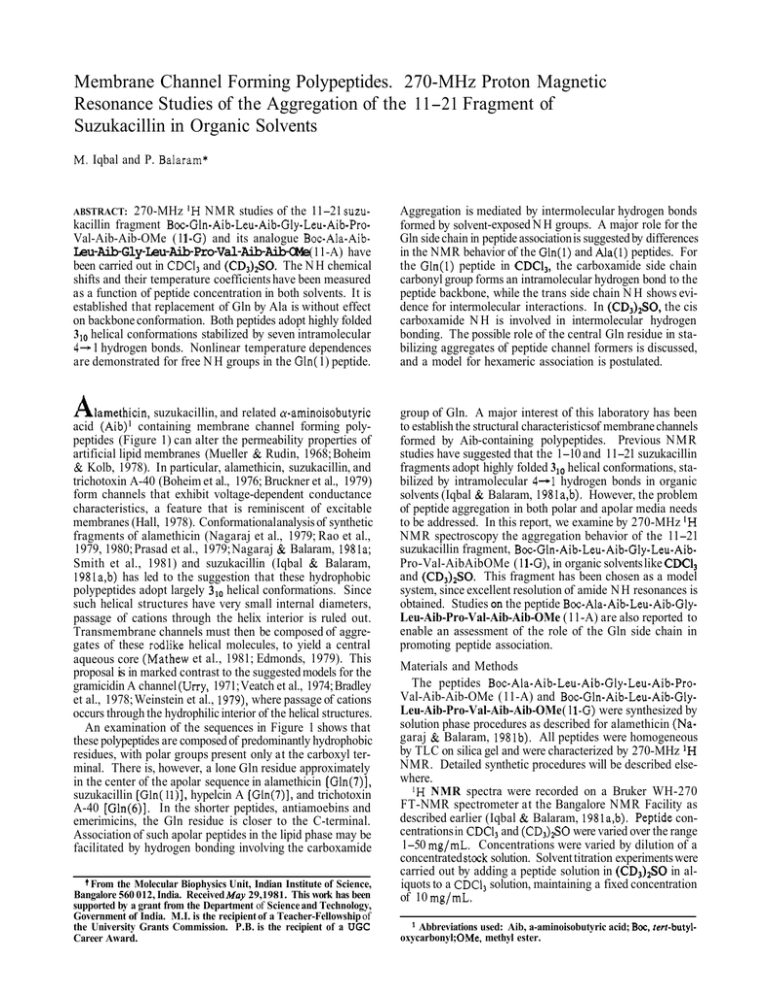
Membrane Channel Forming Polypeptides. 270-MHz Proton Magnetic Resonance Studies of the Aggregation of the 11-21 Fragment of Suzukacillin in Organic Solvents M. Iqbal and P. Balaram* 270-MHz 'H NMR studies of the 11-21 suzuAggregation is mediated by intermolecular hydrogen bonds kacillin fragment Boc-Gln-Aib-Leu-Aib-Gly-Leu-Aib-Pro-formed by solvent-exposed N H groups. A major role for the Val-Aib-Aib-OMe (11-G) and its analogue Boc-Ala-AibGln side chain in peptide association is suggested by differences Leu-Aib-Gly-Leu-Aib-Pro-Val-Aib-Aib-OMe(11-A) have in the NMR behavior of the Gln(1) and Ala(1) peptides. For been carried out in CDCl, and (CDd2S0. The N H chemical the Gln(1) peptide in CDC13, the carboxamide side chain shifts and their temperature coefficients have been measured carbonyl group forms an intramolecular hydrogen bond to the as a function of peptide concentration in both solvents. It is peptide backbone, while the trans side chain N H shows eviestablished that replacement of Gln by Ala is without effect dence for intermolecular interactions. In (CD3)2S0,the cis carboxamide N H is involved in intermolecular hydrogen on backbone conformation. Both peptides adopt highly folded bonding. The possible role of the central Gln residue in sta3 helical conformations stabilized by seven intramolecular 4+ 1 hydrogen bonds. Nonlinear temperature dependences bilizing aggregates of peptide channel formers is discussed, are demonstrated for free N H groups in the Gln( 1) peptide. and a model for hexameric association is postulated. ABSTRACT: A l a m e t hicin, suzukacillin, and related a-aminoisobutyric acid (Aib)' containing membrane channel forming polypeptides (Figure 1) can alter the permeability properties of artificial lipid membranes (Mueller & Rudin, 1968; Boheim & Kolb, 1978). In particular, alamethicin, suzukacillin, and trichotoxin A-40 (Boheim et al., 1976; Bruckner et al., 1979) form channels that exhibit voltage-dependent conductance characteristics, a feature that is reminiscent of excitable membranes (Hall, 1978). Conformational analysis of synthetic fragments of alamethicin (Nagaraj et al., 1979; Rao et al., 1979, 1980; Prasad et al., 1979; Nagaraj & Balaram, 1981a; Smith et al., 1981) and suzukacillin (Iqbal & Balaram, 1981a,b) has led to the suggestion that these hydrophobic polypeptides adopt largely 310 helical conformations. Since such helical structures have very small internal diameters, passage of cations through the helix interior is ruled out. Transmembrane channels must then be composed of aggregates of these rodlike helical molecules, to yield a central aqueous core (Mathew et al., 1981; Edmonds, 1979). This proposal is in marked contrast to the suggested models for the gramicidin A channel (Urry, 1971; Veatch et al., 1974; Bradley et al., 1978; Weinstein et al., 1979), where passage of cations occurs through the hydrophilic interior of the helical structures. An examination of the sequences in Figure 1 shows that these polypeptides are composed of predominantly hydrophobic residues, with polar groups present only at the carboxyl terminal. There is, however, a lone Gln residue approximately in the center of the apolar sequence in alamethicin [Gln(7)], suzukacillin [Gln( 1l)], hypelcin A [Gln(7)], and trichotoxin A-40 [Gln(6)]. In the shorter peptides, antiamoebins and emerimicins, the Gln residue is closer to the C-terminal. Association of such apolar peptides in the lipid phase may be facilitated by hydrogen bonding involving the carboxamide From the Molecular Biophysics Unit, Indian Institute of Science, Bangalore 560 012, India. Received May 29,1981. This work has been supported by a grant from the Department of Science and Technology, Government of India. M.I. is the recipient of a Teacher-Fellowship of the University Grants Commission. P.B. is the recipient of a UGC Career Award. group of Gln. A major interest of this laboratory has been to establish the structural characteristicsof membrane channels formed by Aib-containing polypeptides. Previous NMR studies have suggested that the 1-10 and 11-21 suzukacillin fragments adopt highly folded 3 lo helical conformations, stabilized by intramolecular 4+1 hydrogen bonds in organic solvents (Iqbal & Balaram, 1981a,b). However, the problem of peptide aggregation in both polar and apolar media needs to be addressed. In this report, we examine by 270-MHz 'H NMR spectroscopy the aggregation behavior of the 11-21 suzukacillin fragment, Boc-Gln-Aib-Leu-Aib-Gly-Leu-AibPro-Val-AibAibOMe (11-G), in organic solvents like CDC13 and (CD3)2S0. This fragment has been chosen as a model system, since excellent resolution of amide N H resonances is obtained. Studies on the peptide Boc-Ala-Aib-Leu-Aib-GlyLeu-Aib-Pro-Val-Aib-Aib-OMe (11-A) are also reported to enable an assessment of the role of the Gln side chain in promoting peptide association. Materials and Methods The peptides Boc-Ala-Aib-Leu-Aib-Gly-Leu-Aib-ProVal-Aib-Aib-OMe (11-A) and Boc-Gln-Aib-Leu-Aib-GlyLeu-Aib-Pro-Val-Aib-Aib-OMe (11-G) were synthesized by solution phase procedures as described for alamethicin (Nagaraj & Balaram, 1981b). All peptides were homogeneous by TLC on silica gel and were characterized by 270-MHz 'H NMR. Detailed synthetic procedures will be described elsewhere. 'H NMR spectra were recorded on a Bruker WH-270 FT-NMR spectrometer at the Bangalore NMR Facility as described earlier (Iqbal & Balaram, 1981a,b). Peptide concentrations in CDC1, and (CD3)$0 were varied over the range 1-50 mg/mL. Concentrations were varied by dilution of a concentrated stock solution. Solvent titration experiments were carried out by adding a peptide solution in (CD&3O in aliquots to a CDC1, solution, maintaining a fixed concentration of 10 mg/mL. Abbreviations used: Aib, a-aminoisobutyric acid; Boc, tert-butyloxycarbonyl; OMe, methyl ester. 1 10 5 15 Surukacillin : Ac-Aib - Pro- Val- Aib- Val-Ala -Aib-Ala-Aib-Aib-G 20 24 Leu-Aib-Pro-Val-Aib-Aib-Glu-Gln-Phol 1 Alamethicin I , In-Aib-Leu -Aib- Gly- (Jung et al., 1976 5 10 (n): Ac-Aib-Pro-Aib-AIa-Aib-Ala (Aib1-G in-Aib-Val-Aib-Gly-Leu-Aib- 20 IS Pro- Val- Aib-Aib-Glu- Gln-Phol , (Pandey e t al., 1 9 7 7 a ) 5 - 1. - Hypelcin A : Ac-A tb Pro -Aib-Ala 10 -Aib-Aib-G Aib-Aib-Gln-Gln-Leuol, 20 [n-Leu -Aib-Gly ( F u j i t a et a l . , 1979 1 S 1 10 Trichotoxin A - 4 0 : Ac -Aib-Gly-Aib-Ala-Aib-G[n 15 Leu - A i b - I v a i8 -Aib-Aib-Aib-Ala-Aib-Aib-Pro( Irmscher et al - G l n -Val01 I 5 Emerimicin II (El: Ac-Phe-Aib-Aib-Aib-Val Hyp-Ala 15 -Aib-Aib- Aib-Pro -VaI - (Aibl 4 10 Leu- Aib- Aib- Hyp- Gln- Iva- -Gly- - P h15o l , ., 1978 ) (Pandey et a l . , 1977 b ) 10 5 Antiamoebin : Ac-Phe-Aib-Aib-Iva-Gly-Leu-Aib-Aib-Hyp-GIn-~va-Hyp15 Aib- Pro- Phol, ( P a n d e y e t a l . , 1977c FIGURE 1: Sequence of Aib-containing membrane channel forming polypeptides. 8.0 8,5 7.5 7.0 I I I 8.0 7.5 7.0 I I I 6.5 6.0 5.5 6 .-? rn I I 8.5 8.0 I 7.5 6 7.0 1 6.5 6.0 2: Partial 270-MHz 'H NMR sDectra (NH reeion) of Deptides in (CD&SO: (a) 11-G (0.00086 M, i mg/mL). (bJ 11-A i0:0013 M, 1.5 mg/mL). FIGURE I I I 6.5 60 5.5 I 7.5 8.0 7.0 b 3: Partial 270-MHz 'H NMR spectra (NH region) of 11-G at different concentrations in CDCI,: (a) 0.00086 M; (b) 0.043 M. FIGURE Results Chemical Shifts of NH Resonances. Figure 2a shows the low-field region of the 270-MHz 'H NMR spectrum of a solution of peptide 11-G (0.00086 M) in (CD3),S0. Resonances attributable to the 12 NH groups (10 backbone and 2 side chain) are observed. Singlets, doublets, and triplets are identified by the labels S,, D, and T,, respectively, with the subscripts indicating the order of appearance from low-field in (CD3)2S0. Assignments of doublets to Leu(3) and Leu(6) (D5,D,) and Val(9) (D6) were made on the basis of decoupling experiments, as described earlier (Iqbal & Balaram, 1981b). An unambiguous distinction between the two Leu residues is not possible. The triplet (T,) can be unequivocally assigned to Gly(5) while the Gln( 1) sidechain carboxamide NH groups (Sg and S12)are assigned on the basis of their broadening and disappearance at high temperatures. This feature has been noted in earlier studies of model Gln peptides (Zanacchi & Moore, 1980). The urethane NH of Gln(1) was assigned to the only doublet (Dlo) that broadened at high temperature in (CD3)1;S0,a property frequently observed for the urethane N H in a variety of peptides (Iqbal et al., 1981; M. Iqbal, unpublished results). The remaining five singlets (Sl, Ss,S4, Ss, and SI1)were then assigned to the Aib residues. In our earlier study of the conformation of 11-G, S1 was assigned to the only non-hydrogen-bonded Aib residue in the 310helical structure, i.e., Aib(2) (Iqbal & Balaram, 1981b). The N H resonances of the peptide 11-A in (CD3)2S0 (0.0013 M) are shown in Figure 2b. Assignments of reso- 8.5 I 8.0 I 75 I 6.5 70 b 60 010 I &O I I 7.5 7.0 I I I 66 6.0 5.5 I 5.0 6 FIGURE 4: Partial 270-MHz IH NMR spectra (NH region) of 11-A in CDCl3: (a) 0.0018 M; (b) 0.045 M. nances are based on those for 11-G. The Ala( 1) N H (urethane, Dlo) was unambiguously identified by its high-field position in CDC13, a characteristic of urethane N H groups (Nagaraj et al., 1979; Nagaraj & Balaram, 1981; Iqbal & Balaram, 1981a). The corresponding resonance in (CD3),S0 was identified by solvent titration experiments in CDC1,-(CD3)*S0mixtures. Figures 3 and 4 show the NH resonances of peptides 11-G and 11-A, respectively, in CDC13 at the extreme concentrations used in this study. For 11-G, wellresolved resonances were observed for all 12 N H protons at low concentrations. Some spectral overlap (T, and S,; D5and D6; s8and S,; sl1 and Sg) was observed at high concentrations. However, separation of such overlapping peaks could be obtained in temperature variation experiments, permitting as- 5.8 1 . 1 00018 0.009 0045 Conc 5.3 6.2 1 I 291 I 1\?I21 313 328 293 , , 1 313 I 333 1 64 To K [MI FIGURE 5: (a) Concentration dependence of NH chemical shifts for l l - G in CDC13. (b) Concentration dependence of NH chemical shifts for l l - A in CDC13. (c) Temperature dependence of NH chemical shifts for l l - G (0.00086 M) in (CD3)#0. (d) Temperature dependence of NH chemical shifts for l l - A (0.0013 M). Table I: NMR Parameters of NH Groups in Peptide 11G dG/dT (ppm/"C) X lo3 for (CDJ,SO at d6/dT (ppm/"C) X lo3 for CDC1, at NHa [Aib(2)1 [Gly(5)1 (Aib) (Aib) D, (Leu) D, [Va1(9)1 D, (Leu) S , [Aib(7)1 s, (trans) D,, [Gln(l)l S , , (Aib) S , , (cis) S, T, S, S, 0.000 86 1.7 c c 1.9 3.0 3.5 2.9 0.3 c c 2.3 2.7 0.0086 M 0.043 M A,Sb 0.00086M 0.0086M 0.043M A6b 5.5 5.0 c c 2.0 2.2 2.2 2.3 1.7 c c 1.5 4.3 0.042 0.063 0.090 0.125 -0.008 0.032 0.039 0.241 0.897 0.159 0.243 0.235 c c 2.1 2.1 1.9 2.2 2.1 1.2 4.2 6.1 1.2 5.3 4.8 1.3 2.0 1.8 2.1 2.6 2.8 3.6 5.4 1.8 4.8 5.5 5.0 1.1 1.7 2.0 1.9 3.0 3.3 4.0 6.1 2.3 5.0 -0.213 -0.234 -0.027 -0.050 -0.032 -0.011 -0.090 0.127 -0.039 -0.077 0.053 0.109 4.0 3.0 3.5 1.9 2.0 3.0 1.3 9.0 8.5 1.3 4.0 c Assignments made as discussed earlier (Iqbal & Balaram, 1981b). S, and S,, are the side-chain NH protons of Gln, trans and cis to the A6 is the difference in chemical shift between the highest and lowest concentration values. Negative values indicate upfield shifts with increasing concentration. d6/dT values were not obtained, as the 6 vs. Tplots are nonlinear. CO group, respectively. Table 11: NMR Parameters of NH Groups in Peptide 1l-A d6/dT (ppm/"C) X lo3 for (CDd,SO at &/dT (ppm/"C) X lo3 for CDCl, at NH a a 0.0018 M 0.045 M 4.7 3.1 3.1 2.1 2.8 2.4 3.8 1.6 0.2 5.2 5.8 3.1 3.1 2.0 1.8 1.8 3.3 1.5 0.9 I.8 0.0013 0.452 0.084 0.084 0.099 0.070 0.018 0.062 0.044 0.019 0.840 Assignments made as described in text, by comparison with 11G. signments. In 11-A, excedhgly well-resolved resonances were observed over the entire concentration range. All assignments in CDC13 are based on solvent titration experiments. The Gln(1) NH (Dlo) in l l - G appears at abnormally low field in CDC13, over the entire concentration range, supporting our earlier suggestion that this N H group may be involved in a side chain-backbone hydrogen bond with the CO group of the carboxamide side chain of Gln(1) (Iqbal & Balaram, 1981b). The chemical shifts of the various N H resonances were determined as a function of concentration in order to monitor the effect of peptide association for l l - G and ll-A. Repre- 6.1 5.2 0.9 1.9 2.3 2.3 3.1 4.1 2.4 7.7 0.009 M 0.045 M A6b 6.0 5.3 1.1 2.5 2.4 2.3 3.0 3.7 2.2 7.3 6.4 5.7 1.0 2.3 2.5 2.5 3.4 4.0 2.5 8.4 -0.009 -0.001 0.007 0.007 -0.001 0.004 -0.005 -0.024 -0.008 -0.015 A6 is defined in footnote to Table I. sentative results in CDC13 are summarized in Figure 5a,b. The differences in chemical shifts (A6) at the highest and lowest concentrations studied are presented in Tables I and I1 for l l - G and 11-A, respectively. Temperature Dependence of Chemical Shijts. Intramolecularly hydrogen-bonded N H groups are often delineated on the basis of temperature and solvent dependences of NH chemical shifts (Wuthrich, 1976). Low-tempeature coefficients (d6/dT < 4 X ppm/OC) in hydrogen bond accepting solvents, like (CD3)2S0,are characteristic of solvent shielded and/or intramolecularly hydrogen-bonded N H groups, while d6/dT values > 6 X lo-' ppm/OC are generally assigned to solvent-exposed, free NH groups (Wuthrich, 1976; Hruby, 1974; Venkatachalapathi & Balaram, 198la,b). Temperature coefficient data in relatively nonpolar, poorly hydrogen-bonding solvents like CDCl, may also provide valuable information on peptide structure and aggregation. Stevens et al. (1980) suggest that low d6/dT values (<3 X lo-' ppm/OC) in CDC13 may correspond to either strongly solvent-shielded or completely exposed NH groups. High d6/dT values, on the other hand, may be interpreted as indicative of N H groups participating in intermolecular hydrogen bonding or in weak intramolecular interactions, both of which are disrupted with increasing temperature. A detailed NMR analysis of hydrogen-bonded peptide structure should be facilitated by a comparison of the concentration and solvent dependences of dS/dT values for NH groups. The utility of such studies in approaching the problem of peptide association has been explored in the case of 1-10 suzukacillin fragment (M. Iqbal and P. Balaram, unpublished results). A detailed analysis for the peptides l l - G and l l -A is outlined below. Temperature dependences of NH chemical shifts were measured over the concentration range 0.043-0.00086 M in CDC13 and (CD3)zS0. In (CD3)zS0, l l - G at low concentrations (0.00086 M) shows pronounced curvature of the 6 vs. T plots for resonances S1 [Aib(2)], Tz [Gly(5)], and Slz[the side-chain amide hydrogen of Gln(l), cis to the CO group] (Figure 5c). At 0.043 M, all N H groups show linear temperature dependences. Our earlier study established linear behavior of the NH resonances of l l - G at 0.0086 M in (CD3)zS0(Iqbal & Balaram, 1981b). At low concentration in CDC13, the resonances S9(Gln side-chain amide hydrogen trans to the carbonyl group) and Dlo [Gln(I)] show a nonlinear temperature dependence of chemical shifts. At 0.043 M, the curve for Dlois significantly more linear, while that of S9still exhibits a nonlinear temperature dependence. Further, two overlapping NH resonances (T2) and one Aib NH (S,) show slight deviations from linearity. The upfield shifts with increasing temperature are very much smaller for S3and Tz as compared to S9and Dlo. Deviations from linearity may arise due to structural changes with temperature, resulting in the exposure of an originally solvent-shielded NH group. The d6/dT values for the various N H resonances in l l - G at different concentrations in CDC13and (CD3)$0 are presented in Table I. Seven backbone NH groups (S,,S4,D5, Db, D7, S,,and Sll) show low d6/dT values (<4 X ppm/OC) in (CD3)zS0, over the entire range of concentrations. This suggests the involvement of seven NH groups in intramolecular hydrogen bonding and further supports the contention that the 310 helical conformation proposed earlier (Iqbal & Balaram, 1981b) is largely unaffected by aggregation effects. All N H resonances in l l - A show linear temperature dependences of chemical shifts in both CDC1, and (CD3)$O, over the entire concentration range studied (0.00184.045 M). Figure 5d shows a representative set of data. Further, for ll-A in (CD3)2SO, seven N H groups (S3,S4,DS, D6, D7, Ss,and S,) have relatively low d6/dT values (<4 X lo-' ppm/OC) at all concentrations (Table 11). Figure 6 shows the dependence of N H chemical shifts in l l - A on solvent composition in CDC13-(CD3)zS0 mixtures. Increasing concentration of the strongly hydrogen bond accepting solvent (CDJ2SO perturbs significantly only resonances S1 and Dlowhile the others are insensitive. These results together with the dS/dT values in Table I1 strongly suggest that l l -A adopts a largely 310helical conformation, stabilized by seven strong intramolecular 4+1 hydrogen bonds. This is analogous to the structure suggested b 5 . 6 . ) . 1 10 20 . 1 30 1 I . ' P ? 1 LO 0 10 % (CD3)zSO ' 1 20 ' 1 ' 30 " LO FIGURE 6: Solvent dependence of NH chemical shifts in CDCls(CD3)ZSO mixtures: (a) 11-A, 0.009 M; (b) 11-G, 0.0086 M. for ll-G (Iqbal & Balaram, 198lb) and leads to the conclusion that replacement of Gln( 1) by Ala is without any major effect on the backbone conformation of the peptide. The solventexposed N H groups in ll-A are Aib(2) (Sl) and Ala( 1) (Dlo). The Gly(5) NH (T2) in ll-A has a relatively high ds/dTvalue in (CD&SO [(5.2-5.7) X lo-' ppm/OC] but shows only a small solvent shift in the CDC13-(CD3)zS0system. As proposed earlier for l l - G (Iqbal & Balaram, 1981b), this N H group may participate in a weaker interaction. In both pep tides, the Gly-Leu segment is probably more flexible than the rest of the chain. One Aib NH (S,)shows a comparatively high dG/dT value in (CD&3O but a rather low value in CDC1,. S8may be assigned to Aib(7) NH, since the Gly-Leu type I11 8 turn could be destabilized in a polar solvent like (CD&SO, resulting in disruption of the 4-1 hydrogen bond between Aib(4) CO and the NH of Aib(7). In nonpolar media (CDCl,), the integrity of the 310 helical structure is probably fully maintained. The corresponding Aib(7) NH in l l - G (Ss) may be assigned similarly, on the basis of its high dd/dT value in (CD3)zS0at high concentrations. Interestingly, this resonance exhibits a very large concentration dependence of d6/dTin (CD3)$0, with an increase from 1.2 X lC3ppm/"C at 0.00086 M to 3.3 X lo-, ppm/OC at 0.043 M. A further point of comparison between l l - G and l l - A may be made from the solvent titration curves in Figure 6. In 11-A, the fully solvent-exposed hydrogens, S1 and DI0,show large, monotonic downfield shifts with increasing (CD3)?S0 concentration, while all the other N H groups are relatively insensitive. In 11-G, S1 [Aib(2) NH] shows a large solvent shift at high (CD,)$O concentrations but is insensitive up to about 5% (CD3)$0. Similar discontinuous behavior is also obeerved for S,. These results are suggestive of solvent-dependent structural changes and have earlier been attributed, in the case of S1, to breaking of side chain-backbone hydrogen bonds to the CO of the Gln side chain. The behavior of S8probably arises from destabilization of the Gly-Leu type I11 8 turn. Discussion Highly folded 310helical mnformations have been suggested for the 1-10 and 11-21 suzukacillin fragments (Iqbal & Balaram, 1981a,b) on the basis of lH NMR studies, using solvent titration and temperature coefficient data for delineating hydrogen-bonded N H groups. These structural proposals were also based on the hown propensity of Aib residues to favor type I11 8-turn or 310helical structures (Nagaraj et al., 1979; Rao et al., 1980; Venkatachalapathi & Balaram, 1981b; Venkatachalapathi et al., 1981; Nagaraj & Balaram, 1981a). The present study was designed to probe the modes of peptide association in both polar and nonpolar solvents and A (a1 FIGURE 7: Schematic representation of inter- and intramolecular hydrogen bonding involving the Gln side chain. (a) Association favored in CDC13with trans carboxamide NH participating in an intermolecular hydrogen bond. (b) Association postulated in (CDJgO. Cis carboxamide NH participates in intermolecular hydrgen bonding. to evaluate the role of the Gln residue in stabilizing peptide aggregates. The results described above establish that replacement of Gln( 1) by Ala( 1) does not appreciably alter backbone conformation. Both peptides ll-A and l l -G adopted folded, 310 helical structures stabilized by at least seven intramolecular 4-1 hydrogen bonds. In 11-A, the d6/dT values, for the intramolecularly hydrogen-bonded NH groups, are relatively insensitive to changes in concentration in CDC13 and (CD3)*S0. l l - G behaves similarly except for resonance S8 [Aib(7) NH]. This suggests that even if peptide association occurs, the backbone conformations remain largely unaltered. Further support for this conclusion is obtained from studies which establish that these shielded NH groups show very little concentration dependence of chemical shifts in both peptides. The solvent-exposed (free) NH groups in l l -A and 11-G, however, do exhibit concentration dependence of chemical shifts and temperature coefficients in both solvents. For ll-A in CDC13, both free NH groups S1 [Aib(2)] and Dlo [Ala(l)l show increases in dS/dT values with increasing temperature. These resonances also show large downfield shifts with increasing peptide concentration in CDC13, in marked contrast to the intramolecularly hydrogen-bonded NH groups. These observations suggest that the helical l l -A molecules assdate by intermolecular hydrogen bonding involving exposed NH groups. The increase in d6/dT values in CDC13 with concentration is consistent with an increase in the population of associated species (Stevens et al., 1980; M. Iqbal and P. Balaram, unpublished results). In (CD3),S0, the solvent-exposed NH groups also do not show any concentration dependence of chemical shifts or d6/dT values, suggesting that in polar media peptide association is not appreciable. For l l -G in CDC13, the solvent-exposed backbone NH group S1 [Aib(2)] and Dlo [Gln(l)] show relatively small downfield shifts with increasing concentration. As noted earlier, the urethane NH (Dlo) appears at abnormally lowfield in CDC13over the entire concentration range. Dlo also does not show any concentration dependence of d6/dT values in CDC13. We propose that Gln(1) NH (Dlo) is involved in a hydrogen bond with the CO group of the Gln side chain over the entire concentration range studied. At low concentration (0.00086 M), species in which Aib(2) NH ( S , ) is hydrogen bonded to the Gln side-chain CO are also populated. With increasing concentration, peptide helices aggregate, with Aib(2) N H becoming involved in intermolecular hydrogen bonding. The side chain-backbone interaction in which Gln( 1) NH participates is retained even in the associated species. This interpretation accounts for the low A6 value for S1 (Table I) and also its concentration-dependent dS/dT value. The side-chain carboxamide proton S9 (trans) shows a large downfield shift with increasing concentration in CDC13, whereas S12(cis) is much less concentration dependent. These results suggest that peptide association occurs via hydrogen bonds involving S9,while SI2is relatively free. The nonlinearity in the 6 vs. T curves for S9would then arise from dissociation of aggregated species at higher temperatures. For l l -G in (CD3)$0, of the exposed backbone NH groups, S1shows a large concentration dependence of the shape of the 6 vs. T curves. At low concentration (0.00086 M), there are large deviations from linearity which are abolished at higher peptide concentration (10.0086 M). Dlo exhibits a linear 6 vs. T curve, and the d6/dT values are unaffected by concentration. The results are consistent with the involvement of S1 [Aib(2) NH] in intermolecular association. The low concentration dependence of chemcal shifts in this solvent, as compared to CDC13, is reasonable since in the free molecules the exposed NH groups would bond to (CD3)+30 while in associated species they would interact with a CO group. The chemical shift of the side-chain NH S9(trans) shows a linear temperature dependence, and the d6/dT values are concentration independent. On the contrary, Slz(cis) shows nonlinear temperature dependence of chemical shift at low concentrations (0.00086 M) in (CD3)2S0. At higher concentrations, the 6 vs. T curves are linear, and the d6/dT values are high, characteristic of an exposed N H group. It appears that aggregates in (CD3)*S0may be stabilized by hydrogen bonding involving the cis carboxamide NH (S12),in contrast to CDC13 where the trans NH (S,) is involved. This may arise from the fact that in CDC13the aggregates formed retain the hydrogen bond between Gln( 1) NH and the CO group of the Gln side chain. In such a situation, the trans N H would be sterically more accessible. The modes of intermolecular association suggest in the two solvents are schematically illustrated in Figure 7. The present study establishes that the suzukacillin fragment l l - G aggregates over the concentration range 0.00086 (1 mg/mL)-0.0086 M (10 mg/mL) in (CD3)#0. In CDC13, aggregated species appear to be present even at the lowest concentration studied (0.00086 M). The mode of aggregation in the two solvents differs but is mediated by intermolecular / I I \ I I \ I I FIGURE 8: Proposed model for a hexameric aggregate of channelforming polypeptides like suzukacillin or alamethcin. hydrogen bonds involving the solvent-exposed Aib( 1) NH and Gln side-chain carboxamide protons. Our results suggest that peptide association is strongly favored in nonpolar media. In the case of 11-A and 11-G, aggregation does not affect backbone conformation, and the molecules probably associate as rigid helical rods. This may, in general, be true for the stereochemically rigid Aib-containing peptides. However, in other cases, aggregation could, in principle, involve large changes in backbone conformation. 'H NMR studies of peptides in organic solvents should therefore also address the possible role of aggregation and the consequent effects on NMR parameters. The differences in the behavior of 11-A and 11-G clearly establish an important role for the Gln( 1) side chain in peptide association. It is likely that the aggregation via intermolecular hydrogen bonding between the Gln side chain of one molecule and a backbone amide group of another may be an important factor in stabilizing channelforming peptide aggregates in the apolar phase of biological membranes. Two interesting features of the data presented merit comment. The Gly(5) N H (T,) shows nonlinear 6 vs. T plots for 11-G in CDC13at all concentrations studied (figure not shown) and also at 0.00086 M in (CD3)*SO(Figure 5c). S8[Aib(7)] N H shows a significant increase in d6/dT, with the peptide concentration in (CD3),S0. We speculate that these anomalies associated with Gly(5) and Aib(7) may arise due to involvement of the central segment, -Aib(4)-Gly(S)-Leu(6)-Aib(7)-Pro(8)-, in peptide aggregation. A particularly attractive possibility might involve the Gly(5) CO group in intermolecular hydrogen bonding. In a fully folded 310 helical structure, the regular sequence of 4-1 hydrogen bonds is interrupted by the presence of Pro(8) in 11-G, resulting in a free CO group at Gly(5). We have earlier shown that distorted 310 helical conformations can accomodate a Pro residue in the center of the helix (Venkatachalapathi & Balaram, 1981b; Prasad & Balaram, 1981). The possibility of conformational flexibility in this sequence has also been discussed for the corresponding alamethich fragments (Rao et al., 1980; Nagaraj & Balaram, 1981a). An examination of the sequences in Figure 1 shows that for the longer channel formers, alamethicin, suzukacillin, hypelcin, and trichotoxin A-40, the central Gln residue and the Pro residue at the C-terminal end are separated by seven amino acids in every case. This lends some credence to the hypothesis that spatial relationships between these residues is important. In all four polypeptides, the fourth residue after Gln might provide a free CO group for hydrogen bonding. It is tempting to hypothesize that the Gln side-chain amide group of another molecule would serve as the hydrogen donor. Assuming completely 310 helical conformations for these peptide chains, one can define three distinct helix faces, charcterized by specific side chains. This results from the 3-fold symmetry of the 310helix, together with axial translation, which brings every fourth residue to the same side of the helix. Helix association may occur with adjacent chains running parallel or antiparallel. The central position of the Gln residue in the sequences of the longer channel formers (Figure 1) suggests that both possibilities would lead to reasonably close helix packing. The Gin and Gly (or Gln + idur residues) residues now reside in different helix faces, preventing symmetrical dimeric association. The smallest unit where such association is stereochemically satisfactory, with an appreciable central channel, from preliminary model building, appears to be the hexamer where the Gln side chain of one helix is linked to one neighbor and the Gly CO is linked to the other. This arrangement is schematically represented in Figure 8. Folding of the Gln side chain to form a side chain-backbone hydrogen bond, as in 114, would allow closer approach of the polypeptide helices, permitting additional stabilization by weak van der Waals forces. Such an arrangement is particularly relevant since hexameric aggregates have been implicated in channel functions (Boheim & Kolb, 1978; Edmonds, 1979). The proposed organization of these polypeptide aggregates leads to a channel interior lined with nonpolar side chains. The presence of ordered water in such channels may result in efficient proton translocation across membranes. Some evidence for this has been obtained in studies which demonstrate that alamethicin and synthetic hydrophobic fragments serve as efficient uncouplers of oxidative phosphorylation in mitochondria (Mathew et al., 1981). The peptides examined in this study are too short to form transmembrane channels (Mathew et al., 1981; Nagaraj et al., 1980), precluding a correlation between ease of aggregation and membrane activity. Further studies on larger suzukacillin fragments aimed at evaluating the role of the Gln residue in modulating membrane activity are currently being pursued in this laboratory. References Boheim, G., & Kolb, H. A. (1978) J. Membr. Biol. 38, 99-150. Boheim, G., Janko, K., Liebfritz, D., Ooka, T., Konig, W. A,, & Jung, G. (1976) Biochim. Biophys. Acta 433,182-199. Bradley, R. J., Urry, D. W., Okamoto, K., & Rapaka, R. (1978) Science (Wushington, D.C.) 200, 435-436. Bruckner, H., Konig, W. A., Greiner, M., & Jung, G. (1979) Angew. Chem., Int. Ed. Engl. 18, 476-477. Edmonds, D. T. (1979) Chem. Phys. Lett. 65, 429-433. Fujita, T., Takaishi, Y., & Shimomoto, T. (1979) J . Chem. SOC.,Chem. Commun., 413-414. Hall, J. E. (1978) in Membrane Transport in Biology Concepts and Models (Tosteson, D. C. Ed.) Vol. 1, pp 475-531, Springer-Verlag, Heidelberg and New York. Hruby, V. J. (1974) Chem. Biochem. Amino Acids, Pept. Proteins 3, 1-188. Iqbal, M., & Balaram, P. (1981a) J . Am. Chem. SOC.103, 5548-5552. Iqbal, M., & Balaram, P. (1981b) Biochemistry 20, 4866-487 1. Iqbal, M., Nagaraj, R., & Balaram, P. (1981) Int. J. Pept. Protein Res. (in press). Irmscher, G., Bovermann, G., Boheim, G., & Jung, G. (1978) Biochim. Biophys. Acta 507, 470-484. Jung, G., Konig, W. A., Liebfritz, D., Ooka, T., Janko, J., & Boheim, G. (1976) Biochim. Biophys. Acta 433, 164-181. Mathew, M. K., Nagaraj, R., & Balaram, P. (1981) Biochem. Biophys. Res. Commun. 98, 548-555. Mueller, P., & Rudin, D. 0. (1968) Nature (London) 217, 7 13-7 19. Nagaraj, R., & Balaram, P. (1981a) Biochemistry 20, 2828-2835 . Nagaraj, R., & Balaram, P. (1981b) Tetrahedron 37, 1263-1270. Nagaraj, R., Shamala, N., & Balaram, P. (1979) J. Am. Chem. SOC.101, 16-20. Nagaraj, R., Mathew, M. K., & Balaram, P. (1980) FEBS Lett. 121, 365-368. Pandey, R. C., Carter Cook, J., Jr., & Rinehart, K. L., Jr. (1977a) J. Am. Chem. SOC.99, 8469-8483. Pandey, R. C., Carter Cook, J., Jr., & Rinehart, K. L., Jr. (1977b) J. Am. Chem. SOC.99, 5205-5206. Pandey, R. C., Meng, H., Carter Cook, J., Jr., & Rinehart, K. L., Jr. (1977~)J . Am. Chem. SOC.99, 5203-5205. Prasad, B. V. V., & Balaram, P. (198 1) Int. J. Biol. Macromol. (in press). Prasad, B. V. V., Shamala, N., Nagaraj, R., Chandrasekaran, R. C., & Balaram, P. (1979) Biopolymers 18, 1635-1646. Rao, Ch. P., Nagaraj, R., Rao, C. N. R., & Balaram, P. (1979) FEBS Lett. 100, 244-248. Rao, Ch. P., Nagaraj, R., Rao, C. N. R., & Balaram, P. (1980) Biochemistry 19, 425-43 1. Smith, G. D., Pletnev, V. Z., Duax, W. L., Balasubramanian, T. M., Bosshard, H. E., Czerwinski, E. W., Kendrick, N. E., Mathews, F. S., & Marshall, G. R. (1981) J. Am. Chem. S OC. 103, 1493-1501. Stevens, E. S., Sugawara, N., Bonora, G. M., & Toniolo, C. (1980) J . Am. Chem. SOC.102,7048-7050. Urry, D. W. (1971) Proc. Natl. Acad. Sci. U.S.A. 68, 672-676. Veatch, W. R., Fossel, E. T., & Blout, E. R. (1974) Biochemistry 13, 5249-5256. Venkatachalapathi, Y . V., & Balaram, P. (1981a) Biopolymers 20, 625-628. Venkatachalapathi, Y . V., & Balaram, P. (1981b) Biopolymers 20, 1137-1145. Venkatachalapathi, Y. V., Nair, C. M. K., Vijayan, M., & Balaram, P. (1981) Biopolymers 20, 1123-1136. Weinstein, S., Wallace, B. A., Blout, E. R., Morrow, J. S., & Veatch, W. (1979) Proc. Natl. Acad. Sci. U.S.A. 76, 4230-4234. Wuthrich, K. (1976) NMR in Biological Research: Peptides and Proteins, North-Holland Publishing Co., Amsterdam. Zanacchi, R. M., & Moore, W. J. (1980) Aust. J. Chem. 33, 1505-1510.
